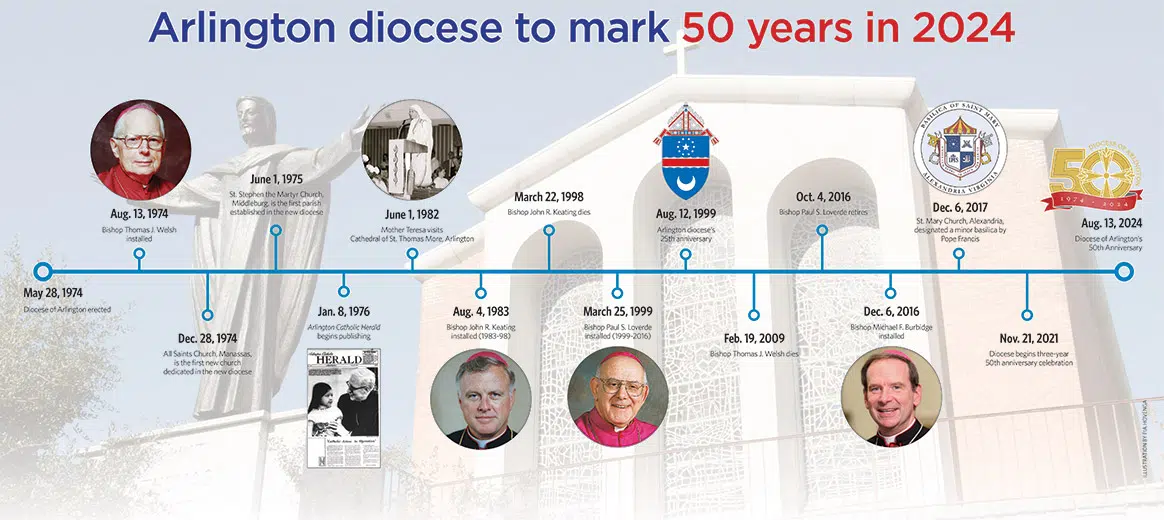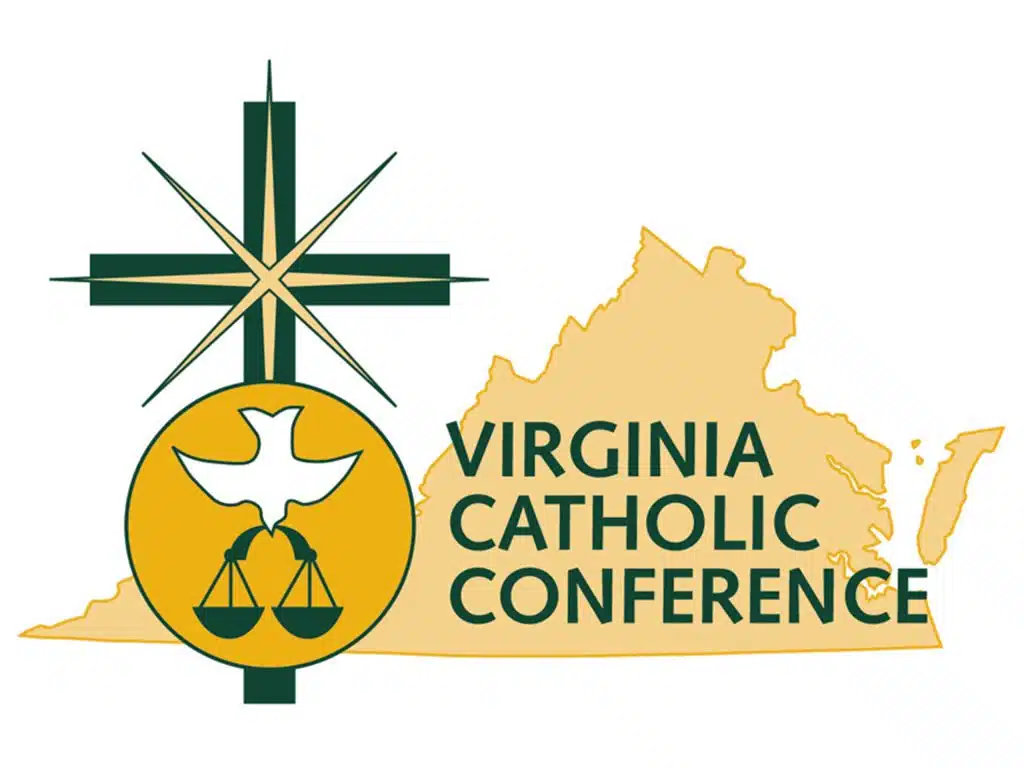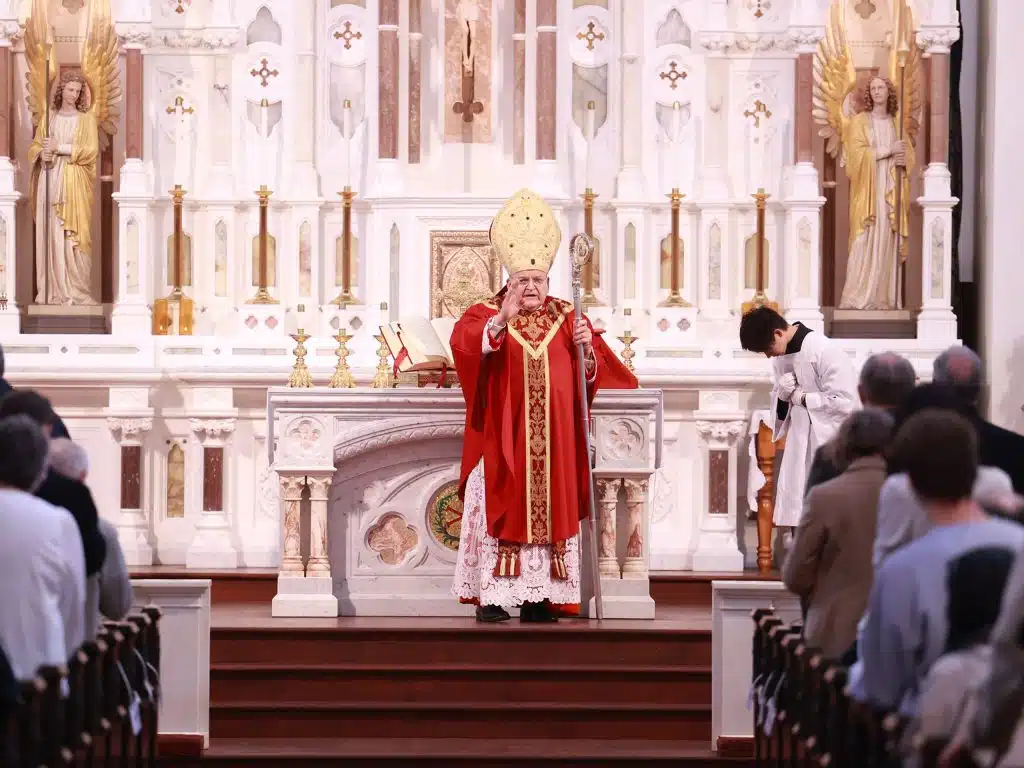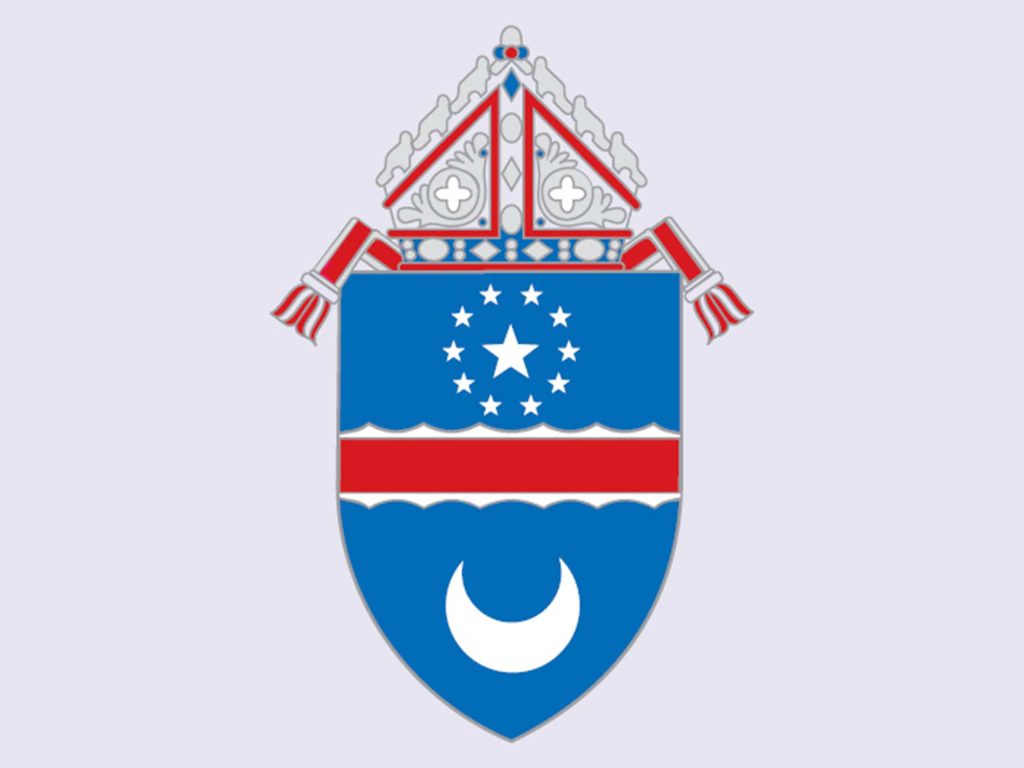A three-year celebration of the Arlington diocese’s Golden Jubilee will kick off this November and continue through the official 50th anniversary in 2024.
The celebration is not just an extended party — the three-year focus is intended to spark “a spiritual and intellectual renewal bearing fruit in evangelization and works of mercy,” according to the Diocese.
Because of the extended COVID-19 crisis, with some people being away from Mass for many months, the bishop and planning team felt that “it would be more fruitful to prepare for the jubilee year, rather than jumping right into it,” said Father Edward C. Hathaway, rector of the Basilica of St. Mary in Alexandria and jubilee co-chair, along with Dan and Mary Beth Riordan, lay co-chairs.
“This three-year period of preparation is a unique opportunity to strengthen our bond as a diocesan family as we celebrate the past with a spirit of gratitude and look to the future with joyful hope,” said Bishop Michael F. Burbidge.
Nine steering committee subgroups have been planning programs and events in areas including marriage and family life, arts and culture, and Catholic schools. “There have been 80 people working on this for a year and half,” Father Hathaway said.
Each year of the three-year celebration will have its own theme, tied to a different aspect of catechesis, he said.
The first preparatory year’s theme is Remember — remembering the past with gratitude. The catechetical focus will be on the Eucharist (“Do this in remembrance of me”). The year will begin on the feast of Christ the King, with solemn vespers, Eucharistic adoration and benediction with Bishop Michael F. Burbidge Nov. 21 at the Cathedral of St. Thomas More in Arlington.
Events throughout the year will include programs on “the meaning of the real Presence and the Mass explained,” Father Hathaway said.
The liturgy subcommittee is coordinating vespers celebrations and monthly Forty Hours Devotions throughout the Diocese, and has put together a guide explaining the devotion, Mary Beth Riordan added.
The second year’s theme is Rejoice — rejoicing in the current vitality of the diocese, with a catechetical focus on Mary as a model of discipleship (“My soul rejoices in the Lord”). The emphasis will be on “Our Lady as the perfect response to the Eucharist. Mary responds to God with her whole being in a beautiful way that all Christians can seek to imitate,” said Father Hathaway. “We will learn more about her role in the church, her piety and devotion.”
The theme of the third year, the actual jubilee year, will be Renew — renewing and strengthening our faith for the future (“Behold, I make all things new”). The catechetical focus will be sharing the Catholic faith with others in word and deed, and the pastoral focus will be on evangelization and works of mercy, Father Hathaway said.
The preparatory years will “strengthen us for the jubilee, to bring other people into the beauty and wonder of the life of the church and shine forth into both spiritual and corporal works of mercy,” Father Hathaway said. This outreach will happen not just at the diocesan level, but also at the regional and parish levels. “Many parishes have apostolates that do works of mercy throughout the year, including Knights of Columbus councils, youth groups and pro-life groups, just to name a few. Multiply all of that by 70 parishes and you see what a tremendous response for works of mercy we could have,” he added.
A new diocesan jubilee website will include news and updates about jubilee events, general information, a letter from Bishop Burbidge and a timeline showing highlights of the history of the Diocese, along with photos, videos and podcasts. The site also will have a section with resources for priests and parishes, as well as posters and printable jubilee materials in English, Spanish, Vietnamese and Korean.
“The story of the Diocese over the past 50 years is a happy story — we’re in a region that’s only been growing,” Father Hathaway said. “We’re not just a larger church than in 1974, but a more richly diverse church today, with more Catholics from all over the world.”
In addition to the diocese’s rich history, it is home to many influential policymakers and government officials. “God has blessed us for a reason, to let the light of the Gospel shine across this very important part of the country,” Father Hathaway said. “This anniversary creates an opportunity to reflect on the truth, goodness and beauty of God.”
AN ILLUSTRIOUS HISTORY
The founding of the Arlington Diocese was announced in May 1974. Bishop Thomas J. Welsh, the founding bishop, was installed Aug. 13, 1974, and St. Thomas More Church in Arlington became the Cathedral of St. Thomas More. But the history of the Catholic Church in Northern Virginia dates back to colonial times.
St. Mary Church (now the Basilica) in Alexandria became the first Catholic parish in Virginia in 1795. In 1808, the territory of the commonwealth of Virginia was included in the newly formed Archdiocese of Baltimore. In 1820, Pope Pius VII established the Diocese of Richmond, which encompassed all of Virginia, including what later became the state of West Virginia — except for the city of Alexandria and Arlington County, which remained part of the Archdiocese of Baltimore until being joined to the Diocese of Richmond in 1858.
Fifty parishes within diocesan boundaries predated the creation of the Diocese; 20 more were added in the past 50 years. The Diocese is now one of the 50 largest in the United States, according to the diocese.
FIRST 50 PARISHES
In 1858, St. Mary of Sorrows in Fairfax became the second parish founded in what is now the Arlington Diocese, when St. Mary Church in Alexandria built a mission church in Fairfax Station to serve Irish railroad workers. The same year, a third St. Mary Church was built in Fredericksburg.
From 1870 to 1972, new parishes were created in what is now the western part of the Diocese: Sacred Heart of Jesus in Winchester (1870); St. John the Evangelist in Warrenton (1874); St. John the Apostle in Leesburg (1926); All Saints in Manassas (1929); St. John the Baptist in Front Royal (1940); Precious Blood in Culpeper and St. Mark in Gordonsville (both 1946); Our Lady of the Valley in Luray (1954); St. John Bosco in Woodstock (1959); St. Francis de Sales in Purcellville (1967); and St. John in Orange (1972).
The number of Catholics in the area around the city of Alexandria and Arlington County also grew steadily from the middle of the 19th century until the middle of the 20th century. Fifty years ago, nearly 40 percent of the parishes that would form the Arlington Diocese were located in the areas of Alexandria, Arlington, Falls Church and McLean. These included (in addition to St. Mary in Alexandria), St. James (1892), St. Charles Borromeo (1909), St. Joseph, Alexandria (1915), St. Rita (1924), St. Agnes (1936), St. Thomas More (1938), Our Lady of Lourdes, Our Lady Queen of Peace, Blessed Sacrament (all 1946), St. Ann (1947), St. Louis (1949), St. John the Beloved (1951), St. Anthony (1952), St. Luke (1961), St. Philip (1962), Queen of Apostles (1963), Good Shepherd (1965) and St. Lawrence (1967).
After World War II, significant population growth took place in the Annandale and Springfield areas, and several new parishes were established: St. Michael (1953), St. Leo (1957), St. Bernadette (1959), Holy Spirit (1964), St. Ambrose (1966) and Nativity (1973).
Similar post-World War II population growth took place in northern and western Fairfax County; parishes established during this period were St. Joseph, Herndon (1950), Our Lady of Good Counsel (1955), St. Mark (1965), St. Timothy (1969), St. Thomas à Becket (1970), and Christ the Redeemer (1972).
To the south, growing Catholic populations led to more new parishes: St. Francis of Assisi in Triangle (1957), Our Lady of Angels, Woodbridge (1959), Holy Family, Dale City (1970) and St. William of York, Stafford (1971). Two on the Northern Neck — St. Elizabeth in Colonial Beach (1917), and St. Francis de Sales, Kilmarnock (1966) — increased to 50 the number of parishes that became part of the newly formed Arlington Diocese on Aug. 13, 1974.
PARISHES 1974-TODAY
The Diocese has added 20 new parishes since then.
Bishop Welsh added seven during his tenure as bishop: St. Stephen the Martyr, Middleburg (1975), St. Elizabeth Ann Seton, Lake Ridge (1976), Our Lady of the Blue Ridge, Madison (1977), St. Catherine of Siena, Great Falls (1979), St. John Neumann, Reston (1979), Holy Martyrs of Vietnam, Arlington (1979) and St. Patrick, Fredericksburg (1983). Also, Christendom College was established in 1977, and Catholic Distance University was established in 1983. Bishop Welsh was named Bishop of Allentown in Pennsylvania in 1983; he died in 2009 at age 87.
Bishop John R. Keating was installed as the Diocese’s second bishop in 1983, and established six new parishes: Sacred Heart, Manassas (1984), St. Andrew the Apostle, Clifton (1989), St. Theresa, Ashburn (1991), St. Paul Chung, Fairfax (1996), St. Clare of Assisi, Clifton (1996) and St. Raymond of Peñafort, Fairfax Station (1997).
While in Rome for his ad limina visit with Pope John Paul II March 22, 1998, Bishop Keating died suddenly of a massive heart attack at age 63, in his 15th year as bishop of Arlington. Msgr. James W. McMurtrie, pastor of St. Theresa Church in Ashburn, was elected to serve as diocesan administrator until a new bishop was installed.
Pope John Paul II named Bishop Paul Loverde, Bishop of Ogdensburg, N.Y., to become the third bishop of Arlington Jan. 25, 1999. He was installed March 25, 1999. That year, Bishop Loverde established St. Matthew Church in Spotsylvania and St. Veronica Church in Chantilly. He established Our Lady of Hope, Potomac Falls, in 2000; Holy Trinity Church, Gainesville, 2001; St. Isidore the Farmer, Orange, 2002; St. Peter Church in Washington, Va., 2005; St. Jude Church, Fredericksburg, 2007, and Corpus Christi Church, Aldie, in 2014. Bishop Loverde announced a new policy in 2006 to allow pastors to decide if girls and women could serve at the altar on a parish-by-parish basis.
Bishop Michael F. Burbidge was installed Dec. 6, 2016 as the fourth bishop of the Diocese, replacing Bishop Emeritus Paul S. Loverde, who had served the Arlington diocese as bishop for more than 17 years. In 2017, Bishop Burbidge announced the creation of the Diocese’s 70th parish, St. Bridget of Ireland in Berryville. It had been a mission of Sacred Heart of Jesus Church in Winchester. In 2018, Bishop Burbidge established two new missions: St. Gabriel Mission in Manassas Park and Our Lady of LaVang Mission in Chantilly, for a total of seven mission churches. St. Mary’s in Alexandria was designated a minor basilica by Pope Francis Dec. 6, 2017.
The Diocese has continued to grow. Currently there are 444,167 registered Catholics (2020) and more than 273 priests, with 50 seminarians in formation. Diocesan Catholic school enrollment was 12,347 children in pre-kindergarten through 8th grade, and 3,573 in diocesan high schools in 2020. Diocesan Catholic Charities doubled its annual revenue over the past five years to $16.3 million last year. Through the generosity of donors, its ministries have been able to respond to dramatic increases in need for food, housing and emergency assistance during the pandemic.
Find out more:



